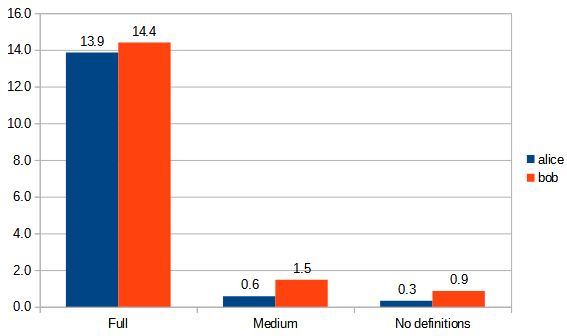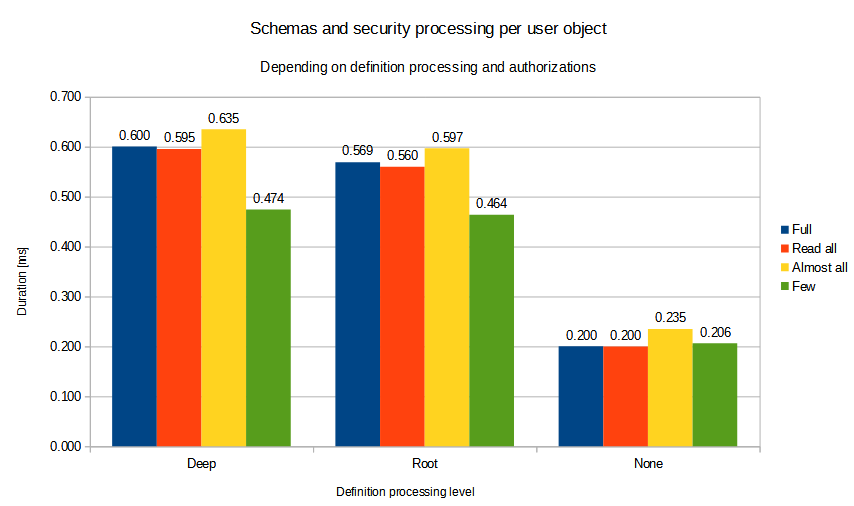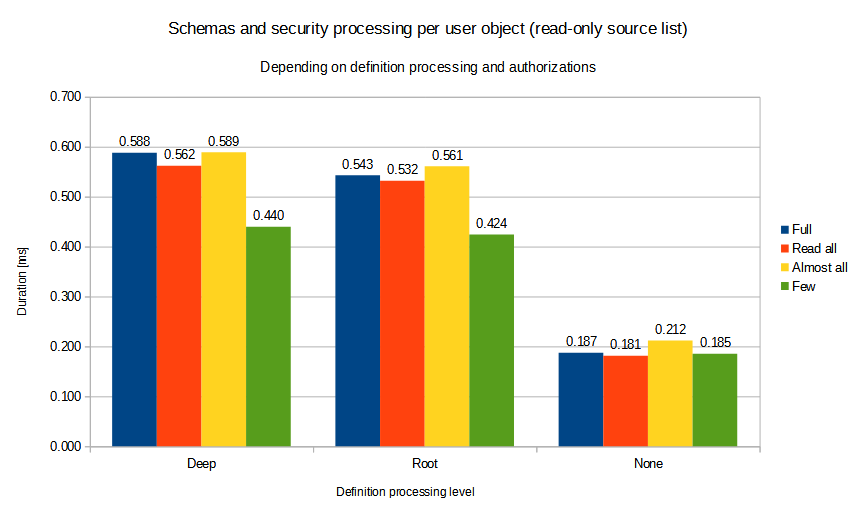
Performance Evaluation
This is a slightly expanded, internal version of Change Summary. It contains details about variants of the solution that were considered and measured during the development.
There are two scenarios: the whole "get object" operation and the sole post-processing. For their description, please see Change Summary.
Initial Measurements of the Whole "Get Object" Operation
First, we tested the overall performance of repeated getObject operation using the following three scenarios concerning applySchemasAndSecurity method:
-
Full updating of both data and definitions (as in 4.7).
-
Updating the data, with all definitions switching to transformable ones (to do template/archetype refinements if there were any). No application of authorizations to definitions.
-
Updating the data only. Definitions were not touched.
At this point, we were not certain whether we will want to refine the schema by templates and archetypes.
| Scenario | alice |
bob |
Improvement (alice) |
Improvement (bob) |
|---|---|---|---|---|
Fully updating data and definitions (4.7) |
13.862 ms |
14.397 ms |
||
Updating data, switching definitions to transformables |
0.577 ms |
1.472 ms |
95.8% |
89.8% |
Updating data, ignoring definitions |
0.334 ms |
0.856 ms |
97.6% |
94.1% |

Later, we moved to lower-level measurements concentrated solely on the post-processing, because that parts of the code we planned to optimize.
Initial Measurements of the Post-Processing
First of all, it was decided that midPoint will _not update the definitions, both top-level and at the level of individual items, with the result of authorization processing.
There are four authorization scenarios:
-
superuser;
-
role that can see the whole user object;
-
role that can see almost all the items (all except one);
-
role that can see only a few items (one extension and one assignment property).
Concerning the definitions, we run the execution in three modes:
| Mode | Description |
|---|---|
Deep |
Schema refinements are executed deeply:
Both in the object-level definition and in lowest item-level definitions (where they are defined).
For example, if |
Root only |
Schema refinements ara executed only in the object-level definition. |
None |
Schema refinements are not applied. |
See also experimental DefinitionUpdateOption class.
The tests were run three times, with the average values summarized here:
| Definitions \ Authorizations | Full | Can read all | Can read almost all | Can read few items |
|---|---|---|---|---|
Deep |
0.600 ms |
0.595 ms |
0.635 ms |
0.474 ms |
Root only |
0.569 ms |
0.560 ms |
0.597 ms |
0.464 ms |
None |
0.200 ms |
0.200 ms |
0.235 ms |
0.206 ms |

Later, the test was slightly optimized: The original list (containing immutable objects) was frozen and re-used, so the real test execution is now much faster. (Creation of test objects, even if done in memory, takes considerable time.)
This had small influence on the performance:

Now, let us concentrate on optimizing the pure authorization application phase, without considering the definitions. (We suppose this will be the mode in the real operation.)
Further Improvements of the Post-Processing
The authorization application was improved in the following stages:
Now the tests were executed as follows:
-
They were run on a separate idle machine (slightly less performant).
-
Each test was run 16 times, with two worst and two best times ignored.
-
Schema refinements from object template and archetype were not applied - i.e., only authorizations were.
-
In order to measure microsecond-level times, the fast tests were executed 20x more times. Moreover, tests in step 2 and 3 were run with detached (and regularly thrown away) operation result objects to avoid out-of-memory conditions. This may have a minor influence on the results. (Testing code for step 2 was back-ported.)
The results are the following:
| Version | Commit | Full | Can read all | Can read almost all | Can read few items |
|---|---|---|---|---|---|
Baseline |
269.7 µs |
255.9 µs |
284.9 µs |
232.4 µs |
|
No |
241.8 µs |
233.2 µs |
266.2 µs |
221.5 µs |
|
Skip needless autz processing |
2.9 µs |
3.7 µs |
188.3 µs |
183.4 µs |

Note about the Improvement Achieved
Overall, the observable performance improvement is mainly due to the elimination of processing that is currently seen as not strictly necessary:
-
tailoring the object definition with authorizations (R - A - M flags) - this made the biggest difference;
-
application of template/archetype refinements to the definition;
-
simplification of internal data structures;
-
using the simplified structures to determine if the authorization application can be skipped altogether.